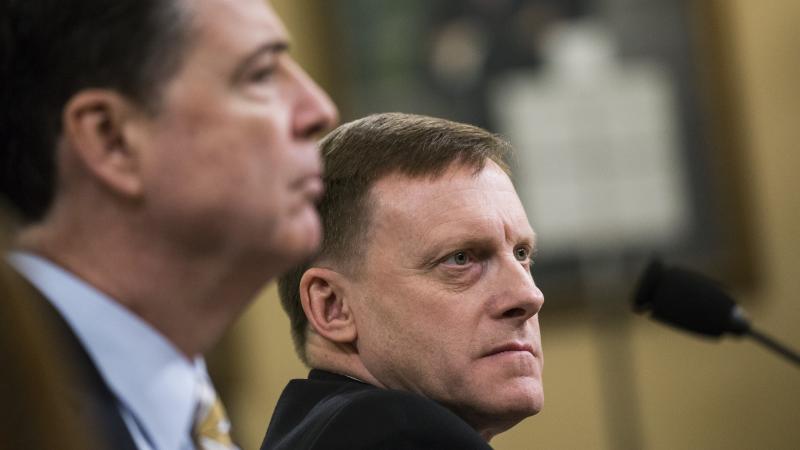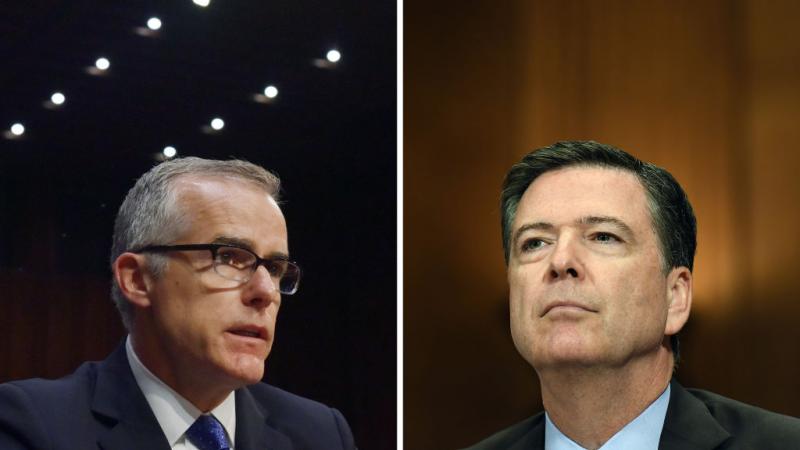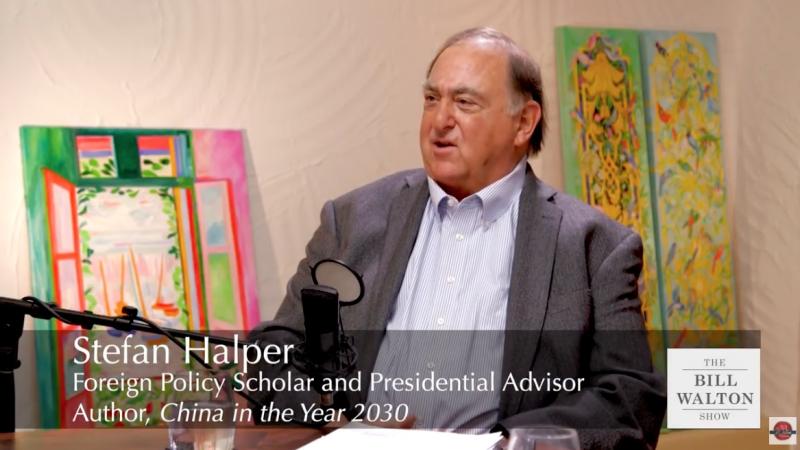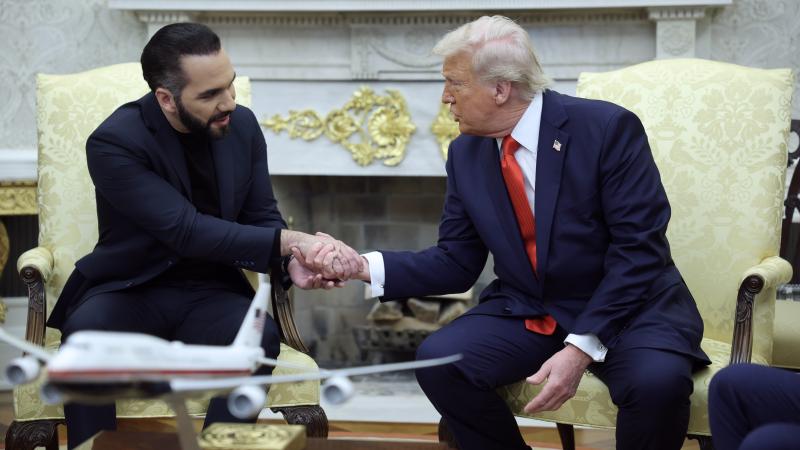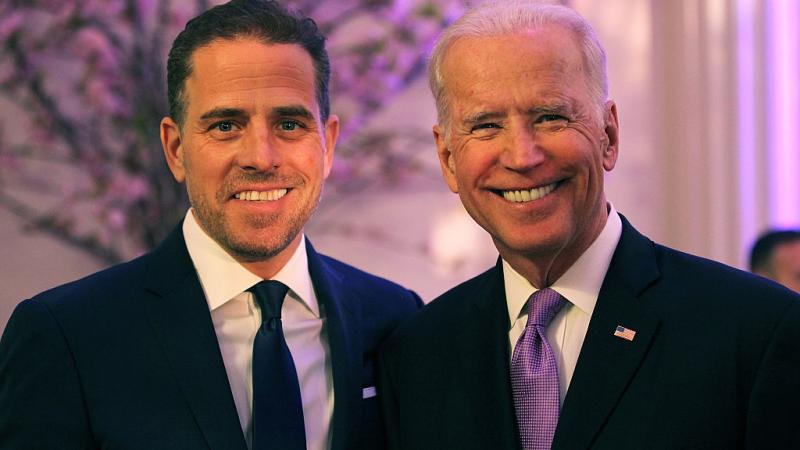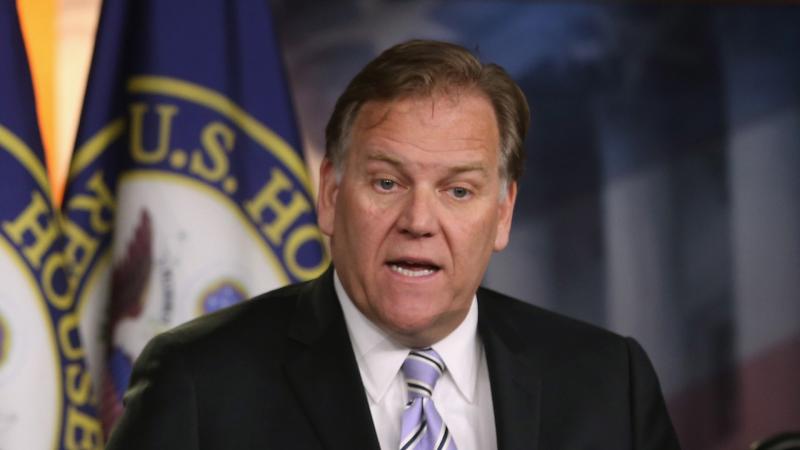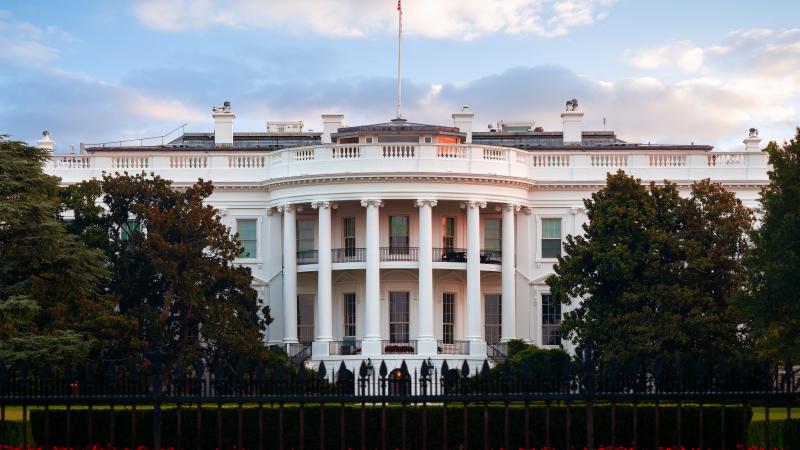Newly declassified Crossfire Hurricane docs shine light on Steele, Clinton, and more
Trump's first attempt at declassifying Crossfire Hurricane documents in January 2021 was thwarted. But now, the FBI records have been released, revealing in part new details on the FBI's problematic Trump-Russia probe.
Newly-declassified FBI documents shine new light on the FBI’s mishandling of its relationship with anti-Trump dossier author Christopher Steele, on the FBI’s double standards on defensive briefings given to Trump and Hillary Clinton, and other key elements of the debunked collusion saga.
Just the News already revealed on Thursday that declassified documents show that Stefan Halper, a key FBI informant in the widely-debunked Russia collusion case, was paid nearly $1.2 million over three decades and was motivated in part by "monetary compensation" — and that he continued snitching for the bureau even after agents concluded he told them an inaccurate story about future Trump National Security Advisor Mike Flynn.
And Just the News also revealed on Friday that the newly-released documents showed that then-NSA director Mike Rogers shot down a Pultizer Prize award-winning Washington Post article about the baseless Russian collusion investigation.
And a new review of hundreds of pages of declassified documents provides new information about the politicized Russiagate scandal — although significant redactions still remain.
This week, FBI Director Kash Patel transmitted to Congress hundreds of pages of declassified documents from the bureau’s "Crossfire Hurricane" investigation related to false claims about Trump-Russia collusion, following a declassification executive order from President Donald Trump last month. Just the News made all 700 pages from the declassified binder available to the public on Thursday.
An investigation by special counsel Robert Mueller “did not establish” any criminal Trump-Russia collusion. DOJ Inspector General Michael Horowitz found huge flaws with the FBI’s investigation, criticizing the“central and essential” role of the dossier in the FBI’s politicized surveillance of former Trump campaign associate Carter Page. Special counsel John Durham’s report concluded that “neither U.S. law enforcement nor the Intelligence Community appears to have possessed any actual evidence of collusion in their holdings at the commencement of the Crossfire Hurricane investigation.”
Admiral Mike Rogers and the Steele Dossier
Admiral Mike Rogers, who retired in 2018 after four years as National Security Agency chief and commander of U.S. Cyber Command, previously expressed a certain level of skepticism about the U.S. intelligence community’s 2017 assessment of alleged Russian meddling in the 2016 election — and a newly declassified interview Rogers gave to the FBI later in 2017 shines light on the dim view Rogers had of British ex-spy Christopher Steele’s discredited dossier.
“ADM Rogers decided that he would make the final analytic call on the NSA’s input to the ICA as he knew there would be a lot of pressure and attention on the final draft and he felt strongly his career analysts shouldn’t have to be responsible for something under such political pressure. In one draft of the ICA, ADM Rogers noted the contents of the ‘Steele dossier’ in the body of the product, which he did not recall seeing in previous drafts,” FBI notes dated June 17, 2017 state.
“In early January, the four principals met and ADM Rogers told the group he was unclear why the ICA needed to focus on the dossier as it was considered largely uncorroborated. Comey responded that the information was relevant and ADM Rogers suggested the information be included in an annex or appendix rather than prominently in the nearly one-page summary he had seen.”
Rogers and Comey, along with Director of National Intelligence James Clapper and CIA Director John Brennan, briefed President-elect Trump about their election meddling findings at Trump Tower in January 2017. Comey stayed behind to tell Trump about some of the dossier’s more salacious allegations.
Steele told the FBI in October 2017 that he was “frustrated” by his dossier’s inclusion in an annex to the ICA. The FBI agent who recounted the interview with Steele wrote, “They brought up the inclusion of their material in the ICA annex multiple times – almost to the point that it felt like fishing for information about how the ICA was constructed. In the end, I made the point that I wasn’t going to get into how the ICA was put together, how the annex came about, etc.”
The Steele dossier annexed to the ICA was largely declassified in 2020, and it relayed some of Steele’s baseless collusion claims: “The most politically-sensitive claims by the FBI source [Steele] alleged a close relationship between the President-elect and the Kremlin. The source also claimed that the President-elect and his top campaign advisers knowingly worked with Russian officials to bolster his chances of beating Secretary Clinton; were fully knowledgeable of Russia’s direction of leaked Democratic emails; and were offered financial compensation from Moscow.”
Varying assessments from intelligence services
The 2017 intelligence assessment concluded with “high confidence” that Russia worked to “undermine public faith in the U.S. democratic process, denigrate former Secretary of State Clinton, and harm her electability and potential presidency” and “developed a clear preference for President-elect Trump.” The NSA diverged on one aspect, expressing only “moderate confidence” that Putin actively tried to help Trump’s election chances and harm those of Clinton.
“I wouldn’t call it a discrepancy. I’d call it an honest difference of opinion between three different organizations,” Rogers told the Senate in 2017. “It didn’t have the same level of sourcing and the same level of multiple sources.”
A 2018 report from the Republican-led House Intelligence Committee concluded that “the majority of the Intelligence Community Assessment judgments on Russia’s election activities employed proper analytic tradecraft” but found the “judgments on Putin’s strategic intentions did not.”
Unmasking saga
The newly-declassified FBI records also show Rogers attempted to distance himself from the FBI’s Crossfire Hurricane investigation.
“ADM Rogers has not been specifically briefed on the FBI investigation into the Russian government’s efforts to interfere in the 2016 presidential election and the nature of links between those efforts and the Trump campaign,” the notes read.” However, ADM Rogers was aware the NSA has received Letterhead Memoranda from the FBI requesting information mostly on specific interactions with U.S. Persons. ADM Rogers was aware the FBI was ‘following specific individuals’ but was not certain if it was because of the ongoing work on the ICA or for another reason.”
The FBI notes also say that “Rogers was surprised when Comey told the committee in open session on March 20, 2017 that the FBI was investigating potential links between individuals associated with the Trump campaign and the Russian interference… Comey did not tell him in advance about the ongoing set of investigations.”
A host of top Obama officials received information in response to “unmasking” requests targeting retired Lt. Gen. Michael Flynn in the final weeks of the Obama administration, according to a memo declassified in 2020.
Republicans have alleged since 2017 that Obama-era officials improperly unmasked associates of then-candidate Trump’s presidential campaign during the Russia collusion investigation, while Democrats have defended the intelligence-gathering process, arguing that the collection of identifying information is inevitable.
John Durham said Rogers cast doubt on collusion claims during an interview with the special counsel team.
“Admiral Mike Rogers served as the Director of NSA during the relevant time period,” the 2023 report said. “When asked about any awareness he had of any evidence of collusion as asserted in the Steele Reports, he stated that he did not recall any intelligence that supported the collusion assertions in that reporting, nor did he have any discussions during the Summer of 2016 with his counterparts in the intelligence community about collusion between the Russians and any Republicans.
State Department awareness of FBI’s relationship with “CROWN”
The FBI also released a slightly less-redacted version of an FBI document detailing the State Department’s awareness of the FBI’s relationship with Steele — who the bureau referred to as “CROWN.”
The newly declassified version shows the document was written by FBI special agent Joseph Pientka on November 16, 2016. The record is titled, “U.S. Department of State Employees Aware of FBI Relationship with CROWN.” A previous version of the document was declassified in 2020.
The FBI said then-Obama and future-Biden State Department official Victoria Nuland had inquired about an October 2016 FBI meeting with Steele — with the declassified document showing the meeting she was asking about was in Rome. The declassified notes say a State Department official may have also been in Rome and met with Steele there.
Outside of unredacting the location of Rome, key bits of the email chains included in the document remain similarly redacted compared to the 2020 version. “This communication documents an email exchange showing the U.S. State Department is receiving CROWN information, however it is not being provided by the FBI,” Pientka wrote.
The records drew out the links between Steele and Hillary Clinton, showing how the former MI6 officer worked with Clinton allies at the State Department to pass to FBI investigators unfounded Russia allegations during an election year.
Steele met with Kathy Kavalec, Deputy Assistant Secretary, Bureau of European Affairs, on Oct. 11, 2016, 10 days prior to the first FISA warrant application targeting Page, after which Kavalec forwarded her notes to the FBI. During the meeting, Steele admitted he was encouraged by his client to get his research out before the 2016 election. Kavalec’s notes also show she found flaws with Steele’s allegations and like others, cast doubt on his credibility.
Steele meets with the FBI in 2017, admits leaking dossier to media
The FBI also released declassified information on Steele’s interview with the FBI in 2017.
Key elements of this document remain hidden behind redactions, including significant redactions related to Steele’s explanations of his various dossier reports and multiple redactions labeled “FGI” — Foreign Government Information. Oddly, Steele’s claim of having information on Rex Tillerson is now redacted.
The interview notes now include alleged main Steele source Igor Danchenko’s name without redactions. The notes also lifted the redaction on Steele, saying Danchenko had worked with Fiona Hill at the Brookings Institution. And the notes now show Steele told the FBI that Danchenko was a “U.S. resident.” Steele outlined Danchenko’s motivations to the FBI — that Danchenko is a U.S. resident, that his daughter was born in the U.S., and Steele was also motivated by “finances.”
Numerous redactions remain related to what Steele said about Danchenko.
The FBI notes now also include interesting comments Steele made about Danchenko’s links to Russia. The FBI had previously redacted part of a section on Danchenko’s contacts with Russian establishments, and the FBI notes now reveal Steele said that Danchenko “had someone over at the Russian Embassy in Washington DC ask [Danchenko] about where they could buy furniture or something like that” with Steele saying that “it was strange, but not alarming.”
Steele also claimed that Danchenko had previously been “hauled in front of immigration authorities in Russia.” While the dossier was being compiled, Steele said Danchenko traveled to Russia three times in 2016. The FBI had previously redacted that Steele told the FBI that Danchenko’s trip to Moscow in 2016 “was paid [for] by an organization funded by the Russian government — in effect, STEELE summarized, Russia paid for his subsource’s third trip to Moscow.”
The prior version of the notes said that “STEELE explained how he shared election-related reports with [redacted]” but the redaction has now been replaced with “FGI” — likely meaning Steele told the bureau he had shared his dossier information with a foreign government official.
Just the News reported on Jan. 19, 2021 that Steele admitted to the FBI that he leaked the Russia collusion story during the height of the 2016 election to help Hillary Clinton overcome her lingering email scandal. He also said he believed Donald Trump's election would be bad for U.S. relations with his home country of Britain, according to documents declassified by Trump in his final full day in office during his first term.
Steele described Trump as "main opponent"
Steele told agents that then-FBI Director James Comey's decision to reopen the Clinton email investigation in fall of 2016 became his tipping point for leaking the anti-Trump collusion research that his company Orbis Intelligence had gathered and given to the FBI.
"STEELE explained that as the election season went on, they as a company were riding two horses — their client and the FBI — and after FBI Director James Comey's reopening of the Hillary Clinton investigation, they had to pick one horse and chose the business client relationship over the relationship with the FBI," the interview report stated.
The declassified documents also showed that Steele and his business partner Christopher Burrows "described President TRUMP as their 'main opponent' and indicated that they were fearful about how Trump's presidency negatively impacted the historical US-UK alliance.”
The FBI documents also showed that the Steele dossier’s alleged main source — Igor Danchenko — had been “introduced to STEELE and ORBIS by FIONA HILL in or around 2011.” Hill, who had worked at the Brookings Institution with Danchenko, went on to serve on the Trump National Security Council and was an impeachment witness in his first term.
The FBI report revealed that "STEELE said FIONA HILL knows that the primary sub-source was involved in the dossier.”
Steele’s claims contradicted Hill’s sworn testimony before the House Intelligence Committee in October 2019. “I have no knowledge whatsoever of how he developed that dossier, none,” Hill said. “The first time I saw that dossier was the day before it was published on BuzzFeed when a colleague, like it seemed to be about half of Washington, D.C., had it, and showed me a copy of it, and I was shocked … That was when I expressed the misgivings and concern that he could have been played.”
Hill told House lawmakers in November 2019 it was Brookings President Strobe Talbott who showed her the dossier. She was critical of Steele’s dossier when she spoke to Congress. Talbot, an Ohio Democrat, was a former Moscow correspondent for Time magazine, and was United States Deputy Secretary of State under Bill Clinton from 1994 to 2001.
“I almost fell over when I discovered that he was doing this report,” Hill said in October 2019. Hill said she met with Steele in 2016 and noted Steele “was clearly very interested in building up a client base,” which made him a target for Russia, calling it “a great opportunity to, basically, you know, present him with information that he’s looking for that can be couched in some truth and some disinformation.”
Hill testified that Steele’s dossier was a “rabbit hole” and Steele “could have been played” by the Russians. Her testimony was part of the Ukraine-related impeachment proceedings, and she stated that “it’s very likely that the Russians planted disinformation” in the dossier, adding, “I don’t believe it’s appropriate for him to have been hired to do this.”
Horowitz’s report on the Russia investigation criticized the DOJ and the FBI for at least 17 “significant errors and omissions” related to the Foreign Intelligence Surveillance Act warrants against Trump campaign associate Carter Page and for the bureau’s reliance on the Democratic-funded dossier compiled by Steele. Steele was hired by Fusion GPS in June 2016, and the opposition research firm had been hired by the Perkins Coie law firm, working for Hillary Clinton’s campaign.
Horowitz noted that Steele’s FBI interview “highlighted discrepancies between Steele’s presentation of information in the election reporting and the views of his Primary Sub-source” and “revealed bias against Trump.”
FBI notes of a January 2017 interview with analyst Igor Danchenko showed he told the bureau he “did not know the origins” of some Steele claims and “did not recall” other dossier information. Danchenko also noted much of what he gave to Steele was “word of mouth and hearsay,” some of which stemmed from a “conversation that [he] had with friends over beers,” and the most salacious allegations may have been made in “jest.”
Horowitz said Danchenko “contradicted the allegations of a ‘well-developed conspiracy’ in” Steele’s dossier. Declassified documents also show the FBI previously investigated Danchenko as a possible “threat to national security.” Danchenko has denied all wrongdoing and was found not guilty in a false statements case brought by Durham.
Steele's payday
Declassified footnotes from the Horowitz report said that Steele received a total of $95,000 from the FBI during his time as a confidential human source for the bureau. Newly-declassified records from the FBI show the bureau’s Validation Management Unit assessed in 2017 that Steele had actually received $127,500 in payments from the bureau.
The FBI offered Steele an “incentive” in October 2016 of up to $1 million if he could prove the allegations in his discredited anti-Trump dossier, but the former MI6 agent was unable to back up his claims, according to 2022 court testimony in Durham’s investigation. An FBI record dated May 2016 said at that point that “the CHS has received a total of $74,000 since being opened in 2013… Another request for $15,000 in service payments is in the system.”
Another FBI record dated July 2016 said that “to date, since 2013, the CHS has been paid $89,000 in service payments.” The FBI record included a request to pay Steele another $7,500.
“Source has provided intelligence regarding the murder of a Russian citizen in Washington DC that ties back to Russian OC [organized crime] members close to government officials in Russia,” the FBI said. An FBI record dated October 18, 2016 said that there was a “$15,000 service payment initiated by the Counterintelligence Division for information from July 5, 2016, to October 3, 2016, to include CHS meeting with CD representatives in Rome on October 3, 2016.”
Joe Pientka praised Steele for helping the Crossfire Hurricane investigation in the document.
“CHS STEELE provides very interesting and unique reporting to the CROSSFIRE HURRICANE investigation. His/her reporting is corroborative of Intel we received from a [Foreign Government Information] that predicated our investigation,” Pientka wrote. “To date, we have not received Intel from other sources that so closely tracks to the predicate," he added.
Strzok's pattern of misleading statements
Notes from an FBI briefing in March 2017 indicate disgraced bureau agent Peter Strzok spread incorrect details about the origins of the Trump-Russia investigation. Strzok incorrectly claimed in his 2020 book, "Compromised," that Australian diplomat Alexander Downer was spurred to inform the U.S. government about a conversation he had in London with Trump campaign associate George Papadopoulos. Mueller and Horowitz concluded Australia actually informed the United States of the Papadopoulos conversation on July 26, 2016.
Strzok also seemed to make that false claim in March 2017 when briefing Justice Department and FBI officials about the Trump-Russia investigation. Strzok admitted in September 2020 he had gotten that detail wrong in his book, though he downplayed it. The alleged mistake was part of a larger pattern.
Handwritten notes labeled as written by Tashina Gauhar, then the associate deputy attorney general, indicate Strzok made the same misleading claim about Trump’s remarks prompting the Australian to reach out to the FBI when briefing then-acting Attorney General Dana Boente and others on March 6, 2017.
The “opening electronic communication” for Crossfire Hurricane was authored by Strzok and authorized by Priestap at the end of July 2016. The investigation didn’t interview Papadopoulos until January 2017.
Durham’s report in 2023 concluded that the investigation was also launched without conducting any interviews of “witnesses essential to understand the raw information” the FBI had received, as well as without using “any of the standard analytical tools typically employed by the FBI in evaluating raw intelligence.” The report asserted that if the bureau had taken these basic steps, “the FBI would have learned that their own experienced Russia analysts had no information about Trump being involved with Russian leadership officials, nor were others in sensitive positions at the CIA, the NSA, and the Department of State aware of such evidence concerning the subject.”
Steele not scrutinized by the FBI until after dossier deployed
The newly-declassified records also included a “Human Source Validation Report” (HSVR) by the FBI’s Validation Management Unit (VMU). The document is still largely redacted.
The VMU assessed in 2017 that the bureau had only “medium confidence” that Steele had contributed to the FBI’s criminal program, in part because “Steele’s reporting has been minimally corroborated.” The unit said that, despite Steele working for the bureau for years, including on the high-profile Trump-Russia collusion investigation, “this is the first HSVR completed on Steele.”
The FBI unit said that, in addition to baseless collusion claims, Steele had provided the bureau with information on a bribery scandal related to FIFA and Russia, a cyberattack from China, and “Weapons of Mass Destruction issues.”
The VMU also claimed that “during Steele’s operation, VMU found no issues regarding his or her reliability” and that “VMU did not locate any information to suggest Steele fabricated information during the operation.”
Declassified footnotes from Horowitz’s report showed that “a 2015 report concerning oligarchs written by the FBI’s Transnational Organized Crime Intelligence Unit (TOCIU) noted that from January through May 2015, ten Eurasian oligarchs sought meetings with the FBI, and five of these had their intermediaries contact Steele.” The TOCIU report “noted that Steele’s contact with five Russian oligarchs in a short period of time was unusual and recommended that a validation review be completed on Steele because of this activity,” Horowitz said. According to Horowitz, the FBI’s Validation Management Unit “did not perform such an assessment on Steele until early 2017” — well after the bureau had deployed the dossier in the FISA court and in the 2017 intelligence community assessment on alleged Russian meddling in the election.
The Horowitz report’s declassified footnotes also said that some of the Steele dossier’s claims about now-former Trump lawyer Michael Cohen were “part of a Russian disinformation campaign to denigrate U.S. foreign relations.” The footnote also added that a U.S. intelligence community report concluded that the Steele dossier’s baseless and salacious claims about Trump at the Ritz-Carlton Moscow were the result of Russian intelligence who "infiltrate[d] a source into the network" managed by Steele.
Steele and his company, Orbis Business Intelligence, worked for Russian oligarch Oleg Deripaska in 2016, allegedly helping recover millions of dollars the Russian oligarch claimed Paul Manafort had stolen from him. Steele sought help in this anti-Trump research effort from Fusion GPS, the founders of the company wrote, and Fusion GPS hired Steele soon after.
The Senate Intelligence Committee’s 2020 report assessed that “the Russian government coordinates with and directs Deripaska on many of his influence operations.” The report found “multiple links between Steele and Deripaska” and “indications that Deripaska had early knowledge of Steele’s work” and said Steele’s relationship with Deripaska “provid[ed] a potential direct channel for Russian influence on the dossier.”
Steele himself admitted in an ABC interview with George Stephanopoulos in 2021 that “I think there is a chance” that Russia fed him disinformation, though he tried to downplay the possibility during the interview.
Lack of corroboration for the dossier
The Crossfire Hurricane team put together a document laying out the wildly unsuccessful efforts taken by the bureau to attempt to verify the claims in Steele’s discredited dossier. A version of the FBI’s dossier corroboration analysis spreadsheet was originally declassified in 2020. The current version, released just a few days ago, only lifted a small number of redactions.
The still-heavily redacted 94-page spreadsheet showed the FBI’s reliance on what it termed “open source” information, including from websites, public speeches, YouTube videos, and news articles. It also showed that many of the biggest dossier claims, including those related to the dossier’s salacious allegations and its baseless claim of a conspiracy between the Trump campaign and the Russians in 2016, showed zero independent corroboration by the bureau.
The FBI analysis from 2016 includes 73 pages of heavily redacted analysis and 21 pages of 390 lightly redacted footnotes that mostly reference publicly available information. Some of the dossier’s claims listed no corroboration beyond the FBI talking to Steele’s main source, Danchenko. The bureau spreadsheet noted that there were some differences between the version of the Steele dossier reports provided to journalists and to the FBI, and corroboration details related to “Other Agency Reporting,” “Sensitive FBI Information,” “Sequestered by Court Order,” and “Sources and Methods” are blacked out throughout the document — while some of the corroboration sections are blank.
There remain large redactions related to information from other U.S. government agencies, FISA Court sequestrations, FBI sources and methods, and sensitive FBI information.
The documents now refer to “Danchenko” instead of “Primary Sub-Source.”
One of the Steele dossier claims was that “Putin and Russian leadership remain worried however and skeptical that Yanukovych has fully covered the traces of these payments to Trump’s former campaign manager.” In the corroboration column, the prior version had been redacted due to “Other Agency Information” and “Sources and Methods” but the newly-released version has removed the second redaction, with the FBI having written: “This applies to mindset and is unable to be verified without Kremlin intercepts. The evidence shows that Russian leadership had reason to worry as of 11/15/2016.”
The dossier had also claimed that “a military wing of the GRU was overseeing [a] hacking operation in the United States.” The corroboration column noted that it had already been widely reported in the press that the Russian intelligence service had carried out hacking against the United States. The prior declassified version of the spreadsheet’s corroboration column said that “this report was shared by [Individual 1] [redacted].” The newly-released version is now just blacked out fully.
The Steele dossier had claimed that “the TRUMP team had agreed to sideline Russian intervention in Ukraine as a campaign issue and to raise US/NATO defence commitment in the Baltics and Eastern Europe to deflect attention away from Ukraine.” In the prior version of the spreadsheet declassified in 2020, the corroboration column was blacked out as “Sensitive FBI Information.” In the newly-released version it remains blacked out, but now with no explanation at all.
In the prior version of the spreadsheet, sometimes the redactions had some identifying information, but there are instances in the new version where those identifications have been replaced just with black lines.
In multiple instances where an additional claim from the Steele dossier was listed, the prior version of the spreadsheet’s corroboration column repeatedly cited “Primary Sub-Source” of Steele, but in the new version the mentions of the sub-source are blacked out.
In another instance laying out a dossier claim, the prior version noted multiple times that a “Subsource Identifies Subsource” but in the new version it is just a redaction without any explanation.
The dossier claimed that “the Trump operation was an ‘open secret’ in Putin’s government circles.” The corroboration column in the prior version said that “this report was shared by [Individual 1]” but this is now fully redacted.
The dossier also claimed that “[one of the filming] occurred in the Presidential Suite of the Ritz Carlton Hotel” and made multiple other baseless claims about the Ritz Carlton. In the prior version, it repeatedly said that “this report was shared by [Individual 1]” but this is now redacted repeatedly.
There remain many redactions — including “OGA” redactions and “Sources and Methods” redactions — related to the dossier’s false claims about former Trump lawyer Michael Cohen being in Prague.
The FBI corroboration column stated that “the CROSSFIRE HURRICANE team has been unable to verify travel by Cohen to the Czech Republic in August 2016.”
A footnote in Horowitz’s report said that some of the Steele dossier’s claims about Cohen were “part of a Russian disinformation campaign to denigrate U.S. foreign relations.” The footnote also added that a U.S. intelligence community report concluded that the Steele dossier’s baseless and salacious claims about Trump at the Ritz Carlton Moscow were the result of Russian intelligence who "infiltrate[d] a source into the network" managed by Steele.
Mueller’s report also debunked Steele’s claim, noting that “Cohen had never traveled to Prague.”
The bureau also listed the Steele dossier’s unverified claim that the “Russian regime has been cultivating, supporting, and assisting Trump for at least 5 years.” The bureau’s “Corroboration / Analyst Notes” for this seemingly relied upon news articles. The FBI also noted that Steele claimed that Trump “accepted a regular flow of intelligence from the Kremlin.” The “Corroboration / Analyst Notes” for that section are just blank.
Steele Dossier circulation in the FBI
The newly-declassified documents also now show a few new details about how the Steele dossier and Steele’s false claims were circulated inside the FBI.
Just the News obtained in 2021 internal FBI emails discussing the Steele dossier. These emails were sent among FBI agents such as fired FBI special agent Peter Strzok, former FBI leader Jonathan Moffa, and at least 13 redacted FBI officials. The newly declassified version lifts redactions on many of the FBI officials who were sending and receiving dossier updates.
The version of the emails also show Steele was called “CROWN” throughout.
The FBI emails from December 2016 include a redacted FBI official with the Washington Field Office sending an email to Strzok, Moffa, and roughly a dozen FBI officials discussing a thumb drive provided by former DOJ official Bruce Ohr. The email includes a “tracking matrix” on the receipt of Steele dossier reports, including from Fusion GPS founder Glenn Simpson.
Marc Elias, a former Perkins Coie lawyer who served as general counsel for Hillary Clinton’s 2016 presidential campaign, played a key role in the funding and spreading of Steele’s discredited dossier. He hired the opposition firm Fusion GPS, which, in turn, hired Steele.
In the previous emails, an FBI official, with his or her name redacted, emailed disgraced FBI agent Peter Strzok and FBI official Jonathan Moffa in December 2016. The email stated: “[REDACTED] will have more background, but I got this from Bruce Ohr on Monday following his breakfast on Saturday with Simpson: The New York Times story from October 3, 2016, that downplayed the connection between Alfa Bank servers and the Trump campaign was incorrect. There was communication and it wasn't spam… I’ll get with [REDACTED] and check the story to see relevance to us.” It is now known the email was sent by FBI agent Joe Pientka and was also sent to FBI analyst Brian Auten, and that the twice redacted name was “Brian” — likely a reference to Auten.
In another December 2016 email, it was known it was sent by [REDACTED] to Moffa and Strzok and was about “Re: Latest CROWN [REDACTED].” It is now known it was sent by FBI official Joe Pientka and that the recipients also included FBI officials Benjamin Gessford, Stephen Somma, Curtis Heide, Brian Auten, Sally Anne Moyer, and Kevin Clinesmith.
Another email in December 2016 is now known to have been sent by Pientka. It was known it had said: “As many of you know we obtained a USB drive from Glenn Simpson via a DOJ colleague. We are handling as evidence and a working copy is in the share drive where we have historically kept CROWN reporting, the folder labeled [REDACTED] Reporting, sub folder Simpson 121216.” It is now known the redaction was the word “Rome” — where Steele had met with the FBI in October 2016.
The FBI documents also include a spreadsheet laying out how Steele dossier reports had been injected into the FBI.
The columns included Steele to the FBI, leftwing journalist David Corn to the FBI, Fusion GPS co-founder Glenn Simpson to the FBI, former Republican Sen. John McCain to the FBI, the version published by BuzzFeed, and [REDACTED]. The redacted column label now says “[FGI”] — indicating Steele dossier reports were sent to the bureau by a yet-unrevealed foreign government.
“I just uploaded to our share drive the documents and files that Bruce Ohr’s wife (through Bruce) voluntarily provided to the FBI this morning,” another December 2016 email states. “They are reports/work she completed for Fusion GPS/Glenn Simpson (similar to the one she gave us on Manafort last week). They are under the Fusion GPS file on the share drive. Please review (there are approx 85 docs...) and once we have a grasp of what's on there I can submit to the appropriate case files.”
The Durham report concluded that “the FISA on Carter Page would not have been authorized without the Steele reporting.”
The newly-revealed FBI recipients of many of these emails were key figures in the Trump-Russia saga.
Auten previously testified that the FBI had offered Steele $1 million in October 2016 if he could corroborate the dossier’s findings — which he could not. Auten later circulated a February 2017 intelligence memo to top FBI officials about the FBI’s Danchenko interview, but Horowitz said it “did not describe the inconsistencies” from the FBI interview in January 2017.
Horowitz said in 2019 that Auten “told us that he factored the Alfa-Bank/Trump server allegations into his assessment of Steele’s reporting.” Auten had been referred by FBI Director Christopher Wray to the Office of Professional Responsibility for disciplinary action following the release of Horowitz’s 2019 FISA abuse report. Durham also revealed the FBI’s inspection division wanted Austen suspended.
In 2020, Auten separately “opened an assessment which was used by an FBI headquarters team to improperly discredit negative Hunter Biden information as disinformation and caused investigative activity to cease,” according to whistleblower allegations made public by Sen. Chuck Grassley (R-IA), who claimed one of the allegations shows “verified and verifiable derogatory information on Hunter Biden was falsely labeled as disinformation.”
Heide was the FBI agent who opened the FBI’s flawed investigation into debunked Alfa Bank claims. Horowitz’s report revealed the FBI had concluded by early 2017 that there were no links between the Trump Organization and Alfa Bank. Heide was also placed under review by the FBI for allegedly concealing information from the FISA Court.
Pientka gave a defensive briefing to Trump in August 2016 which the Crossfire Hurricane team used as a pretext to advance its Trump-Russia investigation. Pientka would later accompany Peter Strzok to interview Flynn in January 2017.
Clinesmith admitted that he falsely edited a CIA email in 2017 to state that Carter Page was “not a source” for the CIA when the agency had actually told the bureau on multiple occasions that Page had been an “operational contact” for the CIA.
Somma and Gessford were the FBI agents who worked with FBI informant Stefan Halper to target the Trump campaign.
“Ultimately, FBI records reflect that it was not until September 19, 2016, that the Crossfire Hurricane team at FBI Headquarters actually received the first six Steele Reports. These Reports were sent to Supervisory Special Agent-I by Handling Agent-1 — some 75 days after Handling Agent-1 first received the initial Report from Steele in London,” the Durham report concluded. “The delayed dissemination within the FBI of the sensational information contained in the Steele Reports is both perplexing and troubling. Indeed, the failure of recollection by FBI personnel concerning the matter certainly raises the question of whether the FBI had misgivings from the start about the provenance and reliability of the Steele Reports. Nevertheless, within two days of their eventual receipt by the Crossfire Hurricane team, information from four of the Steele Reports were being used to support probable cause in the initial FISA application on Carter Page.”
New report from Steele Dossier
The FBI also released a previously nonpublic report from the debunked anti-Trump Steele dossier.
Steele wrote his dossier claims as “Company Intelligence Reports” and, while the bulk of them were made public by BuzzFeed in January 2017, it is known that Steele’s reports numbered 132, 137, and 139 have not previously been made public. The declassified FBI records included a copy of the previously unseen “Company Intelligence Report 2016/132” dated October 13, 2016.
“A former top-level Russian intelligence officer and current Kremlin adviser claimed that President Putin now regretted Moscow’s operation to interfere in the U.S. presidential election in favor of Republican candidate DONALD TRUMP,” Steele claimed. “The officer said the operation now clearly had backfired.” Steele (and many Democrats) would later claim that the alleged Russian meddling efforts got Trump elected.
There is no evidence Steele had sourcing inside the Kremlin. In mid-October 2016, the conventional wisdom was that Hillary Clinton was going to handily defeat Donald Trump in the November election.
Steele’s report baselessly claimed to have intimate knowledge of Putin’s personal thoughts: “Putin’s mistake had been to regard the U.S. political system as more like Russia (corrupt) than something different and to think he understood it sufficiently well to interfere effectively. The Russian president now realized he had been wrong. The TRUMP influence operation had been one of his big mistakes.”
The Durham report concluded that “the FBI was not able to corroborate a single substantive allegation contained in the Steele Reports, despite protracted efforts to do so."
Clinton, Turkey, Trump, and a pretextual briefing
Republicans and conservative commentators have long pointed to a double standard in how FBI defensive briefings were used in high-profile cases involving political figures. Hillary Clinton received a defensive briefing when she was targeted by a foreign government, and defensive briefings were also given to Rep. Eric Swalwell and then-Sen. Dianne Feinstein about their close ties to suspected Chinese agents, which effectively ended the FBI’s criminal or counterintelligence investigations.
The newly-declassified documents reveal that Clinton was targeted by the Turkish government. The foreign power targeting Clinton was redacted in the version obtained by Just the News in January 2021. The newly released FBI documents said the bureau advised top Clinton aides that “the FBI has information that the Government of Turkey is attempting to influence Hillary Clinton through lobbying efforts and campaign contributions.” They were told to advise the FBI if Clinton was approached by anyone tied to Turkey.
The FBI document now unredacted a section on “issues that were known to be important to the Government of Turkey” which included the removal of since-deposed Syrian President Bashar al-Assad, the establishment of a no-fly zone in Syria, U.S. support for Syrian rebels, U.S. military support to Kurdish groups fighting ISIS, and Turkey being linked to the Armenian genocide.
Probe into Clinton and foreign influence suppressed
Declassified memos obtained by Just the News in 2021 showed that FBI agents opened an investigation in late 2014 into a foreign power's effort to curry influence with Clinton's prospective presidential campaign through donations, but the bureau's leadership slow-walked a surveillance warrant and instead arranged for the candidate to get a defensive briefing. Key portions of the document remained redacted until this week.
FBI agents became so frustrated that they were being stonewalled from securing a Foreign Intelligence Surveillance Act warrant to investigate the foreign money plot that they even escalated to then-FBI Director James Comey, according to the memos declassified by Trump in January 2021.
"The FISA application has remained in limbo for the last four months, even though subsequent investigative activity by [redacted] provided additional probable cause for the FISA application," an FBI employee wrote Comey in an April 14, 2015, email in which he expressed concern he was "overstepping" his chain of command by raising his concerns.
That email stated the FBI field office leading the probe was "still uncertain as to why the application has not been sent to DOJ for final approval although several reasons have been put forth by CD [Criminal Division]” and that the decision to put the application on hold originated “on the seventh floor” — meaning it originated with FBI leadership.
Comey wrote back to the agent, "Don't know anything about this but will get smarter."
The memos don't offer any further evidence that a FISA warrant was ever approved. Instead, they show that FBI leadership ultimately decided to give Clinton's team a defensive briefing in October 2015. Clinton's lawyers "were advised the FBI was providing them with this briefing for awareness and so Ms. Clinton could take appropriate action to protect herself," a summary memo stated. "They were also told the FBI was seeking their assistance to identify other appropriate recipients of the brief, if any."
Trump's defensive briefing partly a sham
The FBI’s first intelligence briefing of then-candidate Trump in August 2016 at its New York field office was used as a “pretext” to gather evidence on him and on then-foreign policy adviser Lieutenant General Mike Flynn, according to 2019 testimony from Horowitz. “They sent a supervisory agent to the briefing from the Crossfire Hurricane team, and that agent prepared a report to the file of the briefing about what Mr. Trump and Mr. Flynn said,” Horowitz testified. “So the agent was actually doing the briefing but also using it for the purpose of investigation.”
The FBI has now declassified that FBI special agent Joseph Pientka told Trump during the briefing that the Russians “are more like us in the traditional sense” as he said the Russians “rely on an establishment presence” while the Chinese “take a more asymmetrical approach.” The FBI also declassified that Pientka told Trump that the Chinese asymmetrical presence in the U.S. “could be ten times as large as the symmetrical presence, yet we would not know.”
The version of the FBI briefing document declassified by John Ratcliffe in 2020 said that a U.S. intelligence officer named John Mulligan also briefed Trump, with the document describing Mulligan as the “National Intelligence Manager for [REDACTED].” The new version released by Patel this week redacted Mulligan’s name “due to cover concerns” but now revealed that Mulligan was the intelligence manager for “Iran.”
The James Wolfe interview
The newly-declassified FBI records also include an October 2017 FBI interview with James Wolfe, the former director of security for the Senate Intelligence Committee. Wolfe was indicted in June 2018 for making multiple false statements to the FBI about his contacts with reporters. He would later that year plead guilty to making a false statement to the FBI during the course of an investigation into the unlawful disclosure of classified national security information.
The FBI notes of an interview with Wolfe on October 30, 2017 show Wolfe was asked if he was aware of an article by The Washington Post published on April 11, 2017. The article was titled “FBI obtained FISA warrant to monitor former Trump adviser Carter Page.”
“WOLFE acknowledged he was aware of the FISA… and may have saved communications regarding it being couriered” to the Senate Intelligence Committee, the FBI wrote. “WOLFE initially learned about the FISA through DOJ Office of Legislative Affairs SAM RAMER.” Ramer was a DOJ official during the first Trump term.
The FBI added: “WOLFE asked interviewing agents if there was an investigation into the media leak. [Agent’s note: Interviewing agents did not provide WOLFE a response, but continued the conversation.] WOLFE stated he had not reviewed the FISA.”
Wolfe pleaded guilty to misleading the FBI about his relationships with journalists in October 2018. Judge Ketanji Brown Jackson — now a Supreme Court Justice — sentenced Wolfe to two months in prison.
The Facts Inside Our Reporter's Notebook
Links
- declassified documents
- transmitted to Congress
- all 700 pages from the declassified binder
- did not establish
- Trump-Russia collusion.
- central and essential
- FBI's politicized surveillance
- report
- concluded
- newly declassified interview
- pushing back
- did not merit inclusion
- stayed behind
- frustrated
- concluded
- told
- concluded
- improperly unmasked associates
- newly declassified version
- declassified
- met with Kavalec
- forwarded her notes to the FBI.
- show
- Steele's interview with the FBI
- admitted to the FBI
- documents declassified
- revealed
- sworn testimony
- told
- United States Deputy Secretary of State
- report
- criticized
- related
- the Perkins Coie law firm
- interview
- threat to national security
- not guilty
- footnotes
- records from the FBI
- FBI offered Steele an incentive
- claimed
- concluded
- made the comment
- gotten that detail wrong
- made the same misleading claim
- authored
- concluded
- newly-declassified records
- footnotes
- declassified footnotes
- Russian oligarch Oleg Deripaska
- sought help in this anti-Trump research effort
- report assessed
- admitted
- Russia fed him
- double standard
- defensive briefings were also given
- newly-declassified documents
- version obtained
- remained redacted
- pretext
- 2019 testimony
- declassified
- declassified by John Ratcliffe
- released by Patel
- indicted
- FBI notes of interview
- article
- pleaded guilty
- sentenced Wolfe

